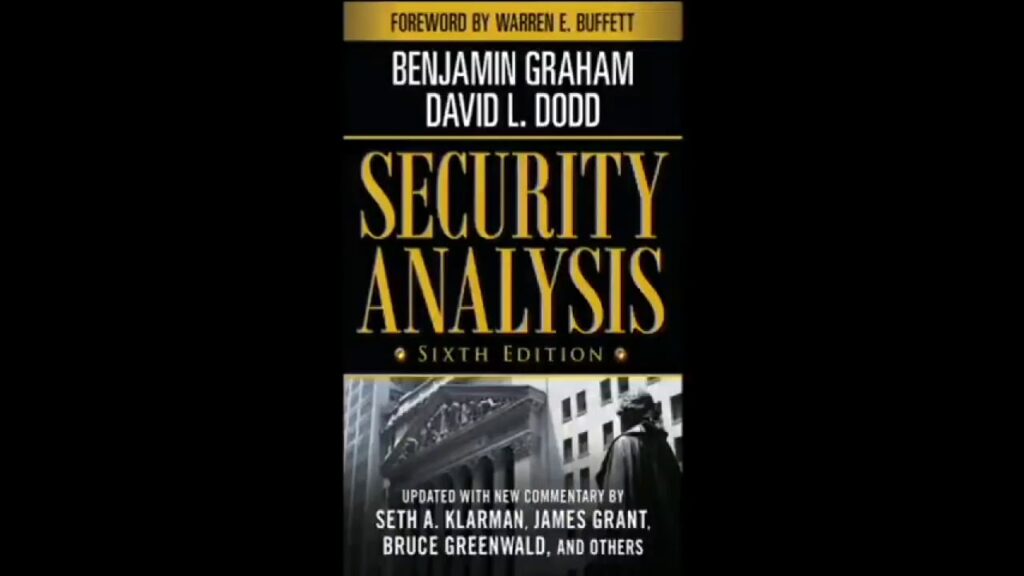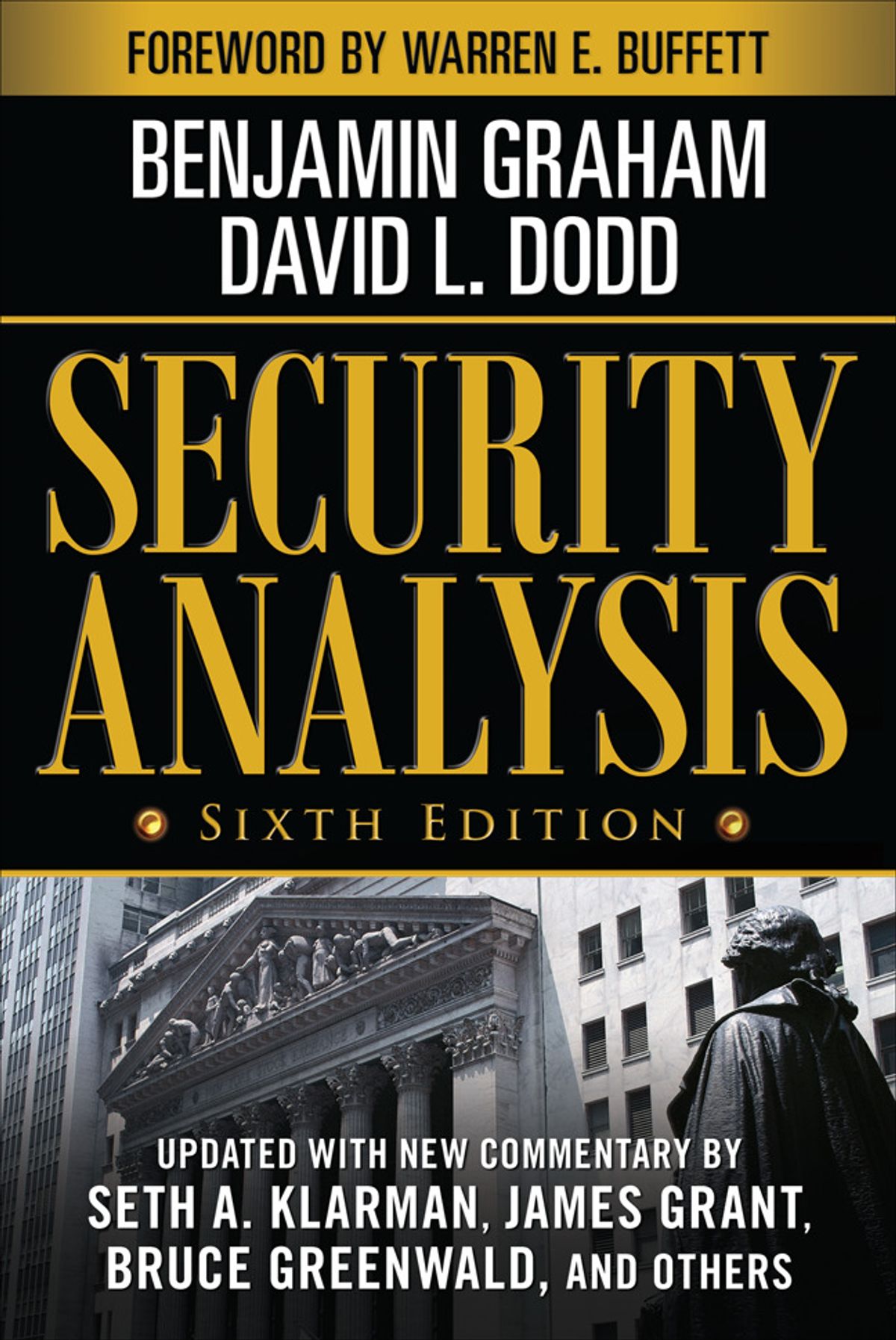Would you like to read a book with amazing investing insights? Are you interested in investing and are pursuing a career in finance? Get Security Analysis by Benjamin Graham PDF and get all the investing insights you need. Security Analysis by Benjamin Graham and David Dodd PDF is a book that laid the intellectual foundation for what would later be called value investing. The first edition was published in 1934, shortly after the Wall Street Crash and the start of the Great Depression. Among other terms, Graham and Dodd coined the term margin of safety in Security Analysis. You can get Intelligent Investor and Security Analysis by Benjamin Graham here at Knowdemia
Table of Contents
Security Analysis by Benjamin Graham PDF Book Details
- Book Title: Security Analysis PDF
- Authors: Benjamin Graham, David L. Dodd, Warren Buffett (Foreword)
- Published: September 1st 2008
- Goodreads Link: Security Analysis by Benjamin Graham
- ISBN: 978-0071592536
- Formats: [PDF] [Epub]
- No. of pages: 299
- Size: 1.7 MB
- Genre: Non-Fiction, Economics, Business, Self-Help,
- Language: English
- File Status: Available for Download
- Price: Free
Security Analysis by Benjamin Graham and David Dodd Book Summary
[Security Analysis by Benjamin Graham summary]
“A road map for investing that I have now been following for 57 years.”
–From the Foreword by Warren E. Buffett
First published in 1934, Security Analysis is one of the most influential financial books ever written. Selling more than one million copies through five editions, it has provided generations of investors with the timeless value investing philosophy and techniques of Benjamin Graham and David L. Dodd.
As relevant today as when they first appeared nearly 75 years ago, the teachings of Benjamin Graham, “the father of value investing,” have withstood the test of time across a wide diversity of market conditions, countries, and asset classes.
Security Analysis sixth edition PDF, based on the classic 1940 version, is enhanced with 200 additional pages of commentary from some of today’s leading Wall Street money managers. These masters of value investing explain why the principles and techniques of Graham and Dodd are still highly relevant even in today’s vastly different markets.
The contributor list includes:
- Seth A. Klarman, president of The Baupost Group, L.L.C. and author of Margin of Safety
- James Grant, founder of Grant’s Interest Rate Observer, general partner of Nippon Partners
- Jeffrey M. Laderman, twenty-five year veteran of BusinessWeek
- Roger Lowenstein, author of Buffett: The Making of an American Capitalist and When America Aged and Outside Director, Sequoia Fund
- Howard S. Marks, CFA, Chairman and Co-Founder, Oaktree Capital Management L.P.
- J. Ezra Merkin, Managing Partner, Gabriel Capital Group .
- Bruce Berkowitz, Founder, Fairholme Capital Management.
- Glenn H. Greenberg, Co-Founder and Managing Director, Chieftain Capital Management
- Bruce Greenwald, Robert Heilbrunn Professor of Finance and Asset Management, Columbia Business School
- David Abrams, Managing Member, Abrams Capital
Featuring a foreword by Warren E. Buffett (in which he reveals that he has read the 1940 masterwork “at least four times”), this new edition of Security Analysis will reacquaint you with the foundations of value investing—more relevant than ever in the tumultuous 21st-century markets.

Security Analysis by Benjamin Graham and David Dodd Review
With nearly a million copies sold, “Security Analysis” has been continuously in print for more than sixty years. No investment book in history had either the immediate impact or the long-term relevance and value, of its first edition in 1934. By 1951, seventeen years past its original publication and more than a decade beyond its revised and acclaimed 1940 second edition, authors Benjamin Graham and David Dodd had seen business and investment markets travel from the depths of the Depression to the heights of recovery and had observed investor behavior during both the calm of peacetime and the chaos of World War II.
The prescient thinking and insight displayed by Graham and Dodd in the first two editions of “Security Analysis” reached new heights in the third edition. In words that could just as easily have been written today as fifty years ago, they detail techniques and strategies for attaining success as individual investors, as well as the responsibilities of corporate decision-makers to build shareholder value and transparency for those investors.
The focus of the book, however, remains its timeless guidance and advice — that careful analysis of balance sheets is the primary road to investment success, with all other considerations little more than distractions. The authors had seen and survived the Great Depression as well as the political and financial instabilities of World War II and were now better able to outline a program for sensible and profitable investing in the latter half of the century.
“Security Analysis: The Classic 1951 Edition” marks the return of this long-out-of-print work to the investment canon. It will reacquaint you with the foundations of value investing — more relevant than ever in tumultuous twenty-first-century markets — and allow you to own the third installment in what has come to be regarded as the most accessible and usable title in the history of investment publishing.

Like the Intelligent investor, this book is a great piece of wisdom, perfectly written, pleasant to follow, with great content. Full of great ideas, I also loved the topic of bonds, the idea that the yield curve inverts because the biggest investment market, the bond market, has smart money that is buying long term bonds because expecting the yields to go down in the future is amazing, and an example of how Warren Buffett can get the big picture in investments
Why You Should Read Security Analysis [Pros]:
Security Analysis is a fascinating read. And if you’re obsessed with investing, or contemplating a career in finance, then it is absolutely a book you can’t miss. It was originally published in 1934 and has stood the test of time (including the scrutiny of Efficient Market Theorists). The latest editions of this classic investing book also have contemporary commentary from modern-day investing legends. It’s really helpful how expert advice is applied to today’s markets.
I mean all markets. Security Analysis covers all types of securities, debt instruments, and asset classes. In fact, when I started reading Security Analysis I was a little bored because the first couple hundred pages are all about investing and valuing various types of bonds. Security Analysis was definitely instructive, but it wasn’t totally applicable to what I was doing. Luckily…
Security Analysis spends hundreds of pages focusing on the different tricks and tactics management can use to deceive investors. It’s really insightful to see these financial sleights of hand called out. And learning how to avoid them makes you a much better investor. But before I get too carried, away, there’s something you should know.
Security Analysis isn’t for everyone…
Who Should NOT Read Security Analysis [Cons]:
Security Analysis is an amazingly in-depth look at equity, debt, and almost any other investment you can think of. But if you’re just getting started out in your investing, this book might discourage you. This is a professional-level discussion about how to figure out what securities are worth, so there is a lot of detail that might bog you down if you’re just getting started.
So what do I recommend?
Beginners might want to avoid this 950-page textbook-style book. Instead: If you’re just starting out with your investing, or you have a more passive interest in picking your stocks, then you would probably be better off reading The Intelligent Investor. This book was published by Ben Graham to make the lessons of Security Analysis a little more digestible for the average person. Intelligent Investor is the book I read before Security Analysis and highly recommend starting there if you’re not familiar with Benjamin Graham. So let me just say one more thing:
If your main focus is day trading stocks or using technical analysis to guide your decision-making, then Security Analysis is not for you. Security Analysis is entirely fundamental in scope. And that’s because it is a veritable bible of Fundamental Analysis. It’s an in-depth reference book that serves as a college textbook at some of the world’s best business schools.
The Best Part About Security Analysis:
Security Analysis is an incredibly instructive read. And since it is so old you can tell it’s stood the test of time. There is a long list of successful investors who have attributed their huge portfolios to the school of value investing. The evidence is pretty overwhelming. This leads me to say: My favorite part about Security Analysis is that you know the information is trustworthy. Now I know that sounds simple… But, it’s especially important in today’s day and age.
Security Analysis – The Final Word
Security Analysis by Benjamin Graham and David Dodd is a book like no other. It gives an objective view on investing intelligently in all sorts of asset classes. After reading this book, I understood why it was so important to Warren Buffet. I use the methodology described every day in every investing decision I make.
Recommendation
If you’re seriously interested in investing and are pursuing a career in finance, Knowdemia.com really recommends you buy Security Analysis on Amazon right now. However, you can download it for free below.
Get Security Analysis by Benjamin Graham Free Download:
Get Security Analysis by Benjamin Graham PDF Free Download by clicking on the button below. You can download Graham Security Analysis PDF or Security Analysis Epub.
OR
